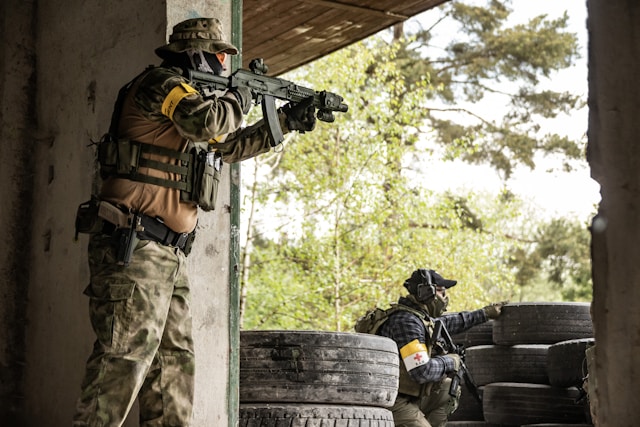Paracord is a highly versatile tool that has become essential in both military and survival settings. Whether you’re a soldier, first responder, or survival enthusiast, paracord can be transformed into a wide array of functional items that are indispensable in the field. Here, I’ll guide you through some of the top paracord projects that not only serve practical purposes but are also easy to create with minimal tools.
Table of Contents
- Understanding Paracord and Its Military Uses
- Essential Knots and Techniques for Paracord Projects
- DIY Paracord Projects for Military Gear
- Paracord Projects for Field Survival and Emergency Preparedness
- Maintenance and Safety Tips for Paracord Gear
1. Understanding Paracord and Its Military Uses
What is Paracord?
Paracord, short for parachute cord, was originally used in the suspension lines of parachutes during World War II. Known for its strength and flexibility, it has since been repurposed for various military and survival applications. The most common type, 550 paracord, can support up to 550 pounds of weight, making it an excellent choice for a range of tactical and emergency uses.
Military Applications of Paracord
In the military, paracord is invaluable for tasks like securing gear, repairing equipment, and constructing emergency shelters. Its inner threads can also be removed and used for sewing, fishing lines, and other survival needs.
2. Essential Knots and Techniques for Paracord Projects
Basic Knots for Military Use
Understanding a few key knots is essential for creating functional paracord projects. Here are three must-know knots:
- Square Knot: Ideal for joining two ends of paracord together.
- Bowline Knot: Known for creating a secure loop that won’t slip.
- Clove Hitch: Useful for fastening paracord to an anchor point, such as a pole or tree.
Step-by-Step Guide to the Cobra Weave
The Cobra Weave is one of the most popular paracord braiding techniques. Here’s how to do it:
- Measure and cut about 10 feet of paracord.
- Fold the cord in half, creating a loop at the folded end.
- Place the loop behind your primary item (e.g., a buckle or D-ring).
- Pull the two ends through the loop and tighten.
- Take the left cord and pass it over the center, then take the right cord and pass it over the left cord, under the center, and through the left loop.
- Tighten the knot and repeat until you reach the desired length.
3. DIY Paracord Projects for Military Gear
Paracord Survival Bracelet
A paracord bracelet is a compact way to carry several feet of cord, which can be deployed in emergencies. Here’s how to make one:
- Cut a length of paracord (typically 8-10 feet) and fold it in half.
- Attach the folded end to a buckle.
- Use the Cobra Weave technique to braid the bracelet, ensuring it fits snugly around your wrist.
- Secure the ends with a knot and trim any excess.
For added customization, you can incorporate unique beads and accessories available at https://nobliecustomknives.com/product-categories/paracord-beads/.

Paracord Rifle Sling
A paracord rifle sling provides extra durability and can double as a survival tool. Here’s a quick overview:
- Measure and cut two pieces of paracord, each approximately 20 feet long.
- Attach the cords to your rifle sling mounts, then use the King Cobra Weave for added thickness.
- Ensure the sling is comfortable on your shoulder and adjust as needed.
- Knot the ends securely, and melt them with a lighter to prevent fraying.
4. Paracord Projects for Field Survival and Emergency Preparedness
Paracord Lanyard for Multitools
Keeping tools accessible is crucial in the field. A paracord lanyard can make sure your gear is always within reach. Follow these steps:
- Cut about 4 feet of paracord and fold it in half.
- Attach the folded end to your multitool’s loop.
- Use the Snake Knot to create a decorative yet functional braid.
- Secure with a knot and trim any extra cord.
Improvised Paracord Tourniquet
Paracord can be used in emergencies to create a tourniquet. However, only use this if trained to do so. Here’s a general approach:
- Wrap the paracord around the injured limb above the wound.
- Tie a loop and insert a stick or sturdy object to twist and tighten.
- Twist until the bleeding stops, but monitor circulation to avoid tissue damage.
- Seek immediate medical assistance.
5. Maintenance and Safety Tips for Paracord Gear
Proper Storage of Paracord
To maintain the integrity of your paracord, store it in a cool, dry place away from direct sunlight, which can degrade the fibers over time.
Inspecting and Replacing Paracord
Regularly inspect your paracord gear for signs of wear, such as fraying or discoloration. Replace any damaged sections immediately to ensure reliability.
Fire Safety Precautions
Always use caution when melting the ends of paracord. Use a lighter to melt the ends, and quickly press them flat with a metal object to prevent burns.
